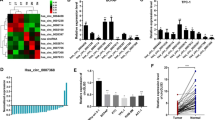Abstract
MicroRNAs are involved in different cancer-related processes. MicroRNA-21 (miR-21), as an oncomiR, is overexpressed in all kinds of tumors and the role of miR-21 in carcinogenesis is elucidated in many cancers gradually. However, the function of miR-21 in osteosarcoma is still unclear. In our study, we found that miR-21 was significantly overexpressed in osteosarcoma tissues. More importantly, we confirmed that knockdown of miR-21 greatly decreased cell invasion and migration of MG-63. Furthermore, we identified that RECK (reversion-inducing-cysteine-rich protein with kazal motifs), a tumor suppressor gene, was a direct target of miR-21. Finally, the expression of RECK protein negatively correlated with the expression of miR-21 in human osteosarcoma tissues, indicating the potential regulation of RECK by miR-21. Our results suggest that miR-21 expression has a key role in regulating cellular processes in osteosarcoma, likely through regulating RECK and may serve as a therapeutic target.





Similar content being viewed by others
References
Marina N, Gebhardt M, Teot L, Gorlick R. Biology and therapeutic advances for pediatric osteosarcoma. Oncologist. 2004;9:422–41.
Wada T, et al. A preliminary report of neoadjuvant chemotherapy NSH-7 study in osteosarcoma: preoperative salvage chemotherapy based on clinical tumor response and the use of granulocyte colony-stimulating factor. Oncology. 1996;53:221–7.
Bartel DP. MicroRNAs: genomics, biogenesis, mechanism, and function. Cell. 2004;116:281–97.
Pillai RS. MicroRNA function: multiple mechanisms for a tiny RNA? RNA. 2005;11:1753–61.
Zamore PD, Haley B. Ribo-gnome: the big world of small RNAs. Science. 2005;309:1519–24.
Bentwich I, et al. Identification of hundreds of conserved and nonconserved human microRNAs. Nat Genet. 2005;37:766–70.
Berezikov E, et al. Phylogenetic shadowing and computational identification of human microRNA genes. Cell. 2005;120:21–4.
Lewis BP, Burge CB, Bartel DP. Conserved seed pairing, often flanked by adenosines, indicates that thousands of human genes are microRNA targets. Cell. 2005;120:15–20.
Ambros V. The functions of animal microRNAs. Nature. 2004;431:350–5.
Hwang HW, Mendell JT. MicroRNAs in cell proliferation, cell death, and tumorigenesis. Br J Cancer. 2006;94:776–80.
Wienholds E, Plasterk RH. MicroRNA function in animal development. FEBS Lett. 2005;579:5911–22.
Chan JA, Krichevsky AM, Kosik KS. MicroRNA-21 is an antiapoptotic factor in human glioblastoma cells. Cancer Res. 2005;65:6029–33.
Iorio MV, et al. MicroRNA gene expression deregulation in human breast cancer. Cancer Res. 2005;65:7065–70.
Diederichs S, Haber DA. Sequence variations of microRNAs in human cancer: alterations in predicted secondary structure do not affect processing. Cancer Res. 2006;66:6097–104.
Roldo C, et al. MicroRNA expression abnormalities in pancreatic endocrine and acinar tumors are associated with distinctive pathologic features and clinical behavior. J Clin Oncol. 2006;24:4677–84.
Volinia S, et al. A microRNA expression signature of human solid tumors defines cancer gene targets. Proc Natl Acad Sci USA. 2006;103:2257–61.
Meng F, et al. MicroRNA-21 regulates expression of the PTEN tumor suppressor gene in human hepatocellular cancer. Gastroenterology. 2007;133:647–58.
Zhu S, Si ML, Wu H, Mo YY. MicroRNA-21 targets the tumor suppressor gene tropomyosin 1(TPM1). J Biol Chem. 2007;282:14328–36.
Asangani IA, et al. MicroRNA-21 (miR-21) post-transcriptionally downregulates tumor suppressor Pdcd4 and stimulates invasion, intravasation and metastasis in colorectal cancer. Oncogene. 2008;27:2128–36.
Gabriely G, et al. MicroRNA-21 promotes glioma invasion by targeting matrix metalloproteinase regulators. Mol Cell Biol. 2008;28:5369–80.
Livak KJ, Schmittgen TD. Analysis of relative gene expression data using real-time quantitative PCR and the 2(-Delta C(T)) method. Methods. 2001;25:402–8.
Si ML, et al. Mir-21-mediated tumor growth. Oncogene. 2007;26:2799–803.
Corsten MF, et al. MicroRNA-21 knockdown disrupts glioma growth in vivo and displays synergistic cytotoxicity with neural precursor cell delivered s-trail in human gliomas. Cancer Res. 2007;67:8994–9000.
Lu Z, et al. MicroRNA-21 promotes cell transformation by targeting the programmed cell death 4 gene. Oncogene. 2008;27:4373–9.
Papagiannakopoulos T, Shapiro A, Kosik KS. MicroRNA-21 targets a network of key tumor-suppressive pathways in glioblastoma cells. Cancer Res. 2008;68:8164–72.
Kang HG, et al. RECK expression in osteosarcoma: correlation with matrix metalloproteinases activation and tumor invasiveness. J Orthop Res. 2007;25:696–702.
Acknowledgments
This research was supported by the National Natural Science Foundation of China (No: 30672130).
Author information
Authors and Affiliations
Corresponding author
Rights and permissions
About this article
Cite this article
Ziyan, W., Shuhua, Y., Xiufang, W. et al. MicroRNA-21 is involved in osteosarcoma cell invasion and migration. Med Oncol 28, 1469–1474 (2011). https://doi.org/10.1007/s12032-010-9563-7
Received:
Accepted:
Published:
Issue Date:
DOI: https://doi.org/10.1007/s12032-010-9563-7




